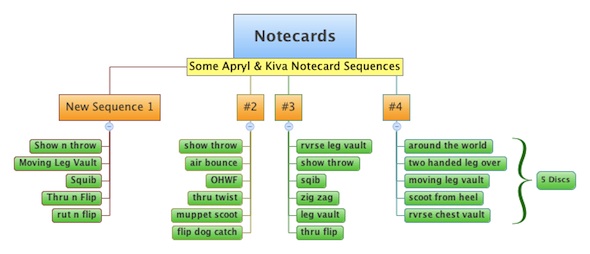The best Routine Building tool that we have been using here at Pawsitive Vybe for more than a few years is a simple set of 3×5 cards. I learned this trick from Chuck Middleton back when I got started in the Dallas Dog and Disc Club and modified it a bit.
What we do is write down all of our tricks on 3×5 notecards, 1 trick per card. Set Up Moves, Dog Catches, cool throws, different flips… each skill or trick that we would like to show people on the field should have it’s own card. Remember that many tricks have two distinct sides or have some special flavor that separates them from the normal version of the trick. We need to be sure to capture all of our tricks and write them on a card. The idea here is to take an inventory of everything we got in our quiver of tricks and get them in a format that we can easily manage and manipulate.
Fresh Sequences Instantly
One of the coolest things about having all of our tricks on Notecards is that we can, at literally any time, simply shuffle and deal the cards and get a fresh perspective on our game.
We shuffle our deck of tricks and draw 5 cards and we have a fresh, 5 trick sequence that we have to figure out how to put together and teach our dogs. We draw the tricks and then we try to play them exactly as drawn. The random draw puts things together that we, as handler’s and players might never think could go together.We want to play these sequences honestly and as efficiently as possible. This is an ever present resource that we can tap for creative sequence building.
What? That’s Crazy!
How about Flipping Dog Catch to Reverse Back Vault? That’s a flip to dog catch immediately followed by a reverse back vault – a vault where the dog flips off the handler’s back. That’s craziness! Would you have ever thought of putting those two tricks together? I didn’t… until drawing those two cards back to back one time during a training session.
I thought about reshuffling, as it didn’t sound like it would go together right off the bat, but as I thought about it, I realized that the key was to toss the dog out of the dog catch to set the appropriate vaulting distance. So not only did I get a cool new part of a sequence, Dog Catch to Reverse Back Vault, but I got the concept of setting the dog up for the next trick out of the dog catch. That’s pretty valuable stuff.
Here are some sequences that Apryl created with her notecards that I found on my computer:

Special Things From the Luck of the Draw
The image above is just four – five card draws in a row. Apryl had fresh and unique combinations of tricks in each draw:
- Sequence #1
“Show and Throw” is just a 7-10 yard throw behind the handler as the dog is going through. This sets the dog at 10 yards, minimum away. Apryl drew a leg vault after the show and throw. She had not been very comfortable working the vault on the run, and had been unconsciously avoiding it. This 5 card draw drew her attention to the skill. It was Awesome! - Sequence #4
Moving Leg Vault to Scoot from Heel forced Apryl to chase Kiva after the leg vault to get into heel position for the Scoot. This was super cool, as it drew attention to handler movement immediately after a vault or an over and how that can increase flow and create interesting team movement.
Putting all of your tricks on notecards and creating sequences by the Luck of the Draw frees up our creativity, and asks us as handlers to develop and exercise our problem solving skills. It’s a great way to learn about Disc Dogging.
Visual and Tacticle Learning Aid
Putting our tricks on notecards also allows visual and tactile learners get their hands and eyeballs wrapped around these sequences and the routine. Tricks can be linked, stacked, grouped, dealt, placed on different areas of a table or desk that represents the field. Our tricks and sequences can become tangible things. We touch and manipulate them.



